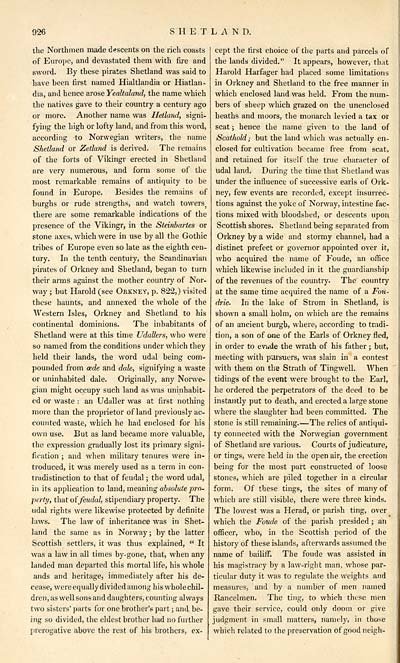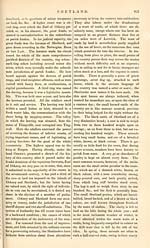Gazetteer of Scotland > Volume 2
(446) Page 926 - SHE
Download files
Complete book:
Individual page:
Thumbnail gallery: Grid view | List view

926
SHE.TLA N D.
tlie Northmen made descents on the rich coasts
of Europe, and devastated them with fire and
sword. By these pirates Shetland was said to
have been first named Hialtlandia or Hiatlan-
dia, and hence arose Yealtaland, the name which
the natives gave to their country a century ago
or more. Another name was Hetland, signi-
fying the high or lofty land, and from this word,
according to Norwegian writers, the name
Shetland or Zetland is derived. The remains
of the forts of Vikingr erected in Shetland
are very numerous, and form some of the
most remarkable remains of antiquity to be
found in Europe. Besides the remains of
burghs or rude strengths, and watch towers ;
there are some remarkable indications of the
presence of the Vikingr, in the Stcinbartes or
stone axes, which were in use by all the Gothic
tribes of Europe even so late as the eighth cen-
tury. In the tenth century, the Scandinavian
pirates of Orkney and Shetland, began to turn
their arms against the mother country of Nor-
way ; but Harold (see Orkney, p. 822,) visited
these haunts, and annexed the whole of the
Western Isles, Orkney and Shetland to his
continental dominions. The inhabitants of
Shetland were at this time Udallers, who were
so named from the conditions under which they
held their lands, the word udal being com-
pounded from cede and dale, signifying a waste
or uninhabited dale. Originally, any Norwe-
gian might occupy such land as was uninhabit-
ed or waste : an Udaller was at first nothing
more than the proprietor of land previously ac-
counted waste, which he had enclosed for his
own use. But as land became more valuable,
the expression gradually lost its primary signi-
fication ; and when military tenures were in-
troduced, it was merely used as a term in con-
tradistinction to that of feudal ; the word udal,
in its application to land, meaning absolute pro-
perty, that of feudal, stipendiary property. The
udal rights were likewise protected by definite
laws. The law of inheritance was in Shet-
land the same as in Norway ; by the latter
Scottish settlers, it was thus explained, " It
was a law in all times by-gone, that, when any
landed man departed this mortal life, his whole
ands and heritage, immediately after his de-
cease, were equally divided among his whole chil-
dren, as well sons and daughters, counting always
two sisters' parts for one brother's part ; and be-
ing so divided, the eldest brother had no further
prerogative above the rest of his brothers, ex-
cept the first choice of the parts and parcels of
the lands divided." It appears, however, that
Harold Harfager had placed some limitations
in Orkney and Shetland to the free manner in
which enclosed land was held. From the num-
bers of sheep which grazed on the unenclosed
heaths and moors, the monarch levied a tax or
scat ; hence the name given to the land of
Scathold ; but the land which was actually en-
closed for cultivation became free from scat,
and retained for itself the true character of
udal land. During the time that Shetland was
under the influence of successive earls of Ork-
ney, few events are recorded, except insurrec-
tions against the yoke of Norway, intestine fac-
tions mixed with bloodshed, or descents upon
Scottish shores. Shetland being separated from
Orkney by a wide and stormy channel, had a
distinct prefect or governor appointed over it,
who acquired the name of Foude, an office
which likewise included in it the guardianship
of the revenues of the country. The country
at the same time acquired the name of a Fou-
drie. In the lake of Strom in Shetland, is
shown a small holm, on which are the remains
of an ancient burgh, where, according to tradi-
tion, a son of one of the Earls of Orkney fled,
in order to evude the wrath of his father ; but,
meeting with pursuers, was slain in a contest
with thern on the Strath of Tingvvell. When
tidings of the event were brought to the Earl,
he ordered the perpetrators of the deed to be
instantly put to death, and erected a large stone
where the slaughter had been committed. The
stone is still remaining. — The relics of antiqui-
ty connected with the Norwegian government
of Shetland are various. Courts of judicature,
or tings, were held in the open air, the erection
being for the most part constructed of loose
stones, which are piled together in a circidar
form. Of these tings, the sites of many of
which are still visible, there were three kinds.
The lowest was a Herad, or parish ting, over
which the Foude of the parish presided ; an
officer, who, in the Scottish period of the
history of these islands, afterwards assumed the
name of bailiff. The foude was assisted in
his magistracy by a law-right man, whose par-
ticular duty it was to regulate the weights and
measures, and by a number of men named
Rancelmen. The ting, to which these men
gave their service, could only doom or give
judgment in small matters, namely, in those
which related to the preservation of good neigh-
SHE.TLA N D.
tlie Northmen made descents on the rich coasts
of Europe, and devastated them with fire and
sword. By these pirates Shetland was said to
have been first named Hialtlandia or Hiatlan-
dia, and hence arose Yealtaland, the name which
the natives gave to their country a century ago
or more. Another name was Hetland, signi-
fying the high or lofty land, and from this word,
according to Norwegian writers, the name
Shetland or Zetland is derived. The remains
of the forts of Vikingr erected in Shetland
are very numerous, and form some of the
most remarkable remains of antiquity to be
found in Europe. Besides the remains of
burghs or rude strengths, and watch towers ;
there are some remarkable indications of the
presence of the Vikingr, in the Stcinbartes or
stone axes, which were in use by all the Gothic
tribes of Europe even so late as the eighth cen-
tury. In the tenth century, the Scandinavian
pirates of Orkney and Shetland, began to turn
their arms against the mother country of Nor-
way ; but Harold (see Orkney, p. 822,) visited
these haunts, and annexed the whole of the
Western Isles, Orkney and Shetland to his
continental dominions. The inhabitants of
Shetland were at this time Udallers, who were
so named from the conditions under which they
held their lands, the word udal being com-
pounded from cede and dale, signifying a waste
or uninhabited dale. Originally, any Norwe-
gian might occupy such land as was uninhabit-
ed or waste : an Udaller was at first nothing
more than the proprietor of land previously ac-
counted waste, which he had enclosed for his
own use. But as land became more valuable,
the expression gradually lost its primary signi-
fication ; and when military tenures were in-
troduced, it was merely used as a term in con-
tradistinction to that of feudal ; the word udal,
in its application to land, meaning absolute pro-
perty, that of feudal, stipendiary property. The
udal rights were likewise protected by definite
laws. The law of inheritance was in Shet-
land the same as in Norway ; by the latter
Scottish settlers, it was thus explained, " It
was a law in all times by-gone, that, when any
landed man departed this mortal life, his whole
ands and heritage, immediately after his de-
cease, were equally divided among his whole chil-
dren, as well sons and daughters, counting always
two sisters' parts for one brother's part ; and be-
ing so divided, the eldest brother had no further
prerogative above the rest of his brothers, ex-
cept the first choice of the parts and parcels of
the lands divided." It appears, however, that
Harold Harfager had placed some limitations
in Orkney and Shetland to the free manner in
which enclosed land was held. From the num-
bers of sheep which grazed on the unenclosed
heaths and moors, the monarch levied a tax or
scat ; hence the name given to the land of
Scathold ; but the land which was actually en-
closed for cultivation became free from scat,
and retained for itself the true character of
udal land. During the time that Shetland was
under the influence of successive earls of Ork-
ney, few events are recorded, except insurrec-
tions against the yoke of Norway, intestine fac-
tions mixed with bloodshed, or descents upon
Scottish shores. Shetland being separated from
Orkney by a wide and stormy channel, had a
distinct prefect or governor appointed over it,
who acquired the name of Foude, an office
which likewise included in it the guardianship
of the revenues of the country. The country
at the same time acquired the name of a Fou-
drie. In the lake of Strom in Shetland, is
shown a small holm, on which are the remains
of an ancient burgh, where, according to tradi-
tion, a son of one of the Earls of Orkney fled,
in order to evude the wrath of his father ; but,
meeting with pursuers, was slain in a contest
with thern on the Strath of Tingvvell. When
tidings of the event were brought to the Earl,
he ordered the perpetrators of the deed to be
instantly put to death, and erected a large stone
where the slaughter had been committed. The
stone is still remaining. — The relics of antiqui-
ty connected with the Norwegian government
of Shetland are various. Courts of judicature,
or tings, were held in the open air, the erection
being for the most part constructed of loose
stones, which are piled together in a circidar
form. Of these tings, the sites of many of
which are still visible, there were three kinds.
The lowest was a Herad, or parish ting, over
which the Foude of the parish presided ; an
officer, who, in the Scottish period of the
history of these islands, afterwards assumed the
name of bailiff. The foude was assisted in
his magistracy by a law-right man, whose par-
ticular duty it was to regulate the weights and
measures, and by a number of men named
Rancelmen. The ting, to which these men
gave their service, could only doom or give
judgment in small matters, namely, in those
which related to the preservation of good neigh-
Set display mode to: Large image | Transcription
Images and transcriptions on this page, including medium image downloads, may be used under the Creative Commons Attribution 4.0 International Licence unless otherwise stated. ![]()
| Gazetteers of Scotland, 1803-1901 > Gazetteer of Scotland > Volume 2 > (446) Page 926 - SHE |
|---|
| Permanent URL | https://digital.nls.uk/97436174 |
|---|
| Description | Volume II: Glenbanchor to Zetland. |
|---|---|
| Attribution and copyright: |
|
| Description | By Robert Chambers and William Chambers. Glasgow: Blackie & Son, 1838. 2 volumes. |
|---|---|
| Shelfmark | NF.1461.g.7 |
| Additional NLS resources: | |

